Nudge-Based Intervention for Cognitive Enhancement of Elderly in Long-Term Care Facilities During Fire Evacuation According to Urgent-Level Circumstances
Abstract
1. Introduction
2. Nudge-Based Evacuation-Inducing Factors (Nudging Factors)
| Literature | Nudging Factor | |||||||||||
|---|---|---|---|---|---|---|---|---|---|---|---|---|
| Guide Lines | Guidance Light | Hand-Rails | Path Guidance Device | Fire Alarm System | Voice Evacuation System | |||||||
| Interval | Location | Color | Shape | Interval | Height | Color | Size | |||||
| D’Orazio et al. [28] | ● | ● | ● | ● | ● | ● | ● | ● | ● | |||
| Proulx and Bénichou [29] | ● | ● | ● | |||||||||
| Kobes et al. [30] | ● | ● | ||||||||||
| Ran et al. [31] | ● | ● | ● | |||||||||
| Kobes et al. [32] | ● | |||||||||||
| Kubota et al. [33] | ● | ● | ||||||||||
| ISO 3864-1 [34] | ● | ● | ● | |||||||||
| Kubota et al. [35] | ● | |||||||||||
| Smedberg et al. [36] | ● | |||||||||||
| Kinateder et al. [37] | ● | |||||||||||
| Balboa et al. [38] | ● | |||||||||||
| Li et al. [62] | ● | |||||||||||
| Kim et al. [39] | ● | |||||||||||
| Olander et al. [22] | ● | |||||||||||
| Galea et al. [40] | ● | ● | ||||||||||
| Zhang et al. [41] | ● | ● | ● | ● | ||||||||
| Rigos et al. [42] | ● | ● | ||||||||||
| Rousek and Hallbeck [43] | ● | |||||||||||
| Menzemer et al. [24] | ● | ● | ||||||||||
| Wang et al. [44] | ● | |||||||||||
3. Methodology
3.1. Intervention Forms of the Nudging Factors
3.2. Scenarios Under Urgent-Level Circumstances
3.3. Data Collection
3.4. Hybrid AHP–TOPSIS
4. Results
4.1. Nudging Factor
4.2. Intervention Forms of Nudging Factors
5. Discussion
5.1. Nudging Factors in Terms of Cognitive Enhancement During Elderly Evacuation
5.2. Elderly Cognitive Enhancement According to Urgent-Level Circumstances
5.3. Bridging the Knowledge Gap Between Academic and Practice Experts
6. Conclusions
Author Contributions
Funding
Data Availability Statement
Acknowledgments
Conflicts of Interest
Abbreviations
| AHP | Analytic Hierarchy Process |
| TOPSIS | Technique for Order of Preference by Similarity to Ideal Solution |
| avg. | Average |
References
- Zhang, F.; Chan, A.P.C.; Li, D. Evaluating Building Egress Safety for the Elderly under Different Urgent-Level Circumstances in High-Density Cities: Based on ABEM-Enabled Simulation. Int. J. Disaster Risk Reduct. 2023, 87, 103587. [Google Scholar] [CrossRef]
- D’Orazio, M.; Spalazzi, L.; Quagliarini, E.; Bernardini, G. Multi-Agent Simulation Model for Evacuation of Care Homes and Hospitals for Elderly and People with Disabilities in Motion. In Ambient Assisted Living; Longhi, S., Siciliano, P., Germani, M., Monteriù, A., Eds.; Springer International Publishing: Cham, Switzerland, 2014; pp. 197–204. [Google Scholar]
- Hanapi, N.L.; Ahmad, S.S.; Norhati, lbrahim; Razak, A.A.; Ali, N.M. Suitability of Escape Route Design for Elderly Residents of Public Multi-Storey Residential Building. Pertanika J. Soc. Sci. Humanit. 2017, 25, 251–258. [Google Scholar]
- Folk, L.; Gonzales, K.; Gales, J.; Kinsey, M.; Carattin, E.; Young, T. Emergency Egress for the Elderly in Care Home Fire Situations. Fire Mater. 2020, 44, 585–606. [Google Scholar] [CrossRef]
- Rahouti, A.; Lovreglio, R.; Nilsson, D.; Kuligowski, E.; Jackson, P.; Rothas, F. Investigating Evacuation Behaviour in Retirement Facilities: Case Studies from New Zealand. Fire Technol. 2021, 57, 1015–1039. [Google Scholar] [CrossRef]
- Li, J.; Wang, J.; Jin, B.; Wang, Y.; Zhi, Y.; Wang, Z. Evacuation of Nursing Home Based on Massmotion: Effect of the Distribution of Dependent Elderly. KSCE J. Civ. Eng. 2020, 24, 1330–1337. [Google Scholar] [CrossRef]
- Lui, G.C.H.; Tong, L.Y.C. Survey on Total Fire Safety in Residential Care Homes for Elderly Persons in Hong Kong. WIT Trans. Inf. Commun. Technol. 2010, 43, 171–182. [Google Scholar]
- D’Orazio, M.; Bernardini, G.; Longhi, S.; Olivetti, P. Evacuation Aid for Elderly in Care Homes and Hospitals: An Interactive System for Reducing Pre-Movement Time in Case of Fire. In Ambient Assisted Living: Italian Forum 2014; Andò, B., Siciliano, P., Marletta, V., Monteriù, A., Eds.; Springer International Publishing: Cham, Switzerland, 2015; pp. 169–178. ISBN 978-3-319-18374-9. [Google Scholar]
- Bernardini, G.; Quagliarini, E.; D’Orazio, M.; Santarelli, S. How to Help Elderly in Indoor Evacuation Wayfinding: Design and Test of a Not-Invasive Solution for Reducing Fire Egress Time in Building Heritage Scenarios. In Ambient Assisted Living; Cavallo, F., Marletta, V., Monteriù, A., Siciliano, P., Eds.; Springer International Publishing: Cham, Switzerland, 2017; pp. 209–222. [Google Scholar]
- Gerges, M.; Penn, S.; Moore, D.; Boothman, C.; Liyanage, C. Multi-Storey Residential Buildings and Occupant’s Behaviour during Fire Evacuation in the UK: Factors Relevant to the Development of Evacuation Strategies. Int. J. Build. Pathol. Adapt. 2018, 36, 234–253. [Google Scholar] [CrossRef]
- Fu, L.; Cao, S.; Song, W.; Fangx, J. The Influence of Emergency Signage on Building Evacuation Behavior: An Experimental Study. Fire Mater. 2018, 43, 22–33. [Google Scholar] [CrossRef]
- Rendón Rozo, K.; Arellana, J.; Santander-Mercado, A.; Jubiz-Diaz, M. Modelling Building Emergency Evacuation Plans Considering the Dynamic Behaviour of Pedestrians Using Agent-Based Simulation. Saf. Sci. 2019, 113, 276–284. [Google Scholar] [CrossRef]
- Qu, L.; Wang, Y.; Cao, Y. Fire Safety in High-Rise Buildings under Elderly Housing. IOP Conf. Ser. Earth Environ. Sci. 2019, 238, 012055. [Google Scholar] [CrossRef]
- D’Orazio, M.; Longhi, S.; Olivetti, P.; Bernardini, G. Design and Experimental Evaluation of an Interactive System for Pre-Movement Time Reduction in Case of Fire. Autom. Constr. 2015, 52, 16–28. [Google Scholar] [CrossRef]
- Dostal, P.J. Vulnerability of Urban Homebound Older Adults in Disasters: A Survey of Evacuation Preparedness. Disaster Med. Public Health Prep. 2015, 9, 301–306. [Google Scholar] [CrossRef] [PubMed]
- Droby, A.; El Mendili, M.M.; Giladi, N.; Hausdorff, J.M.; Maidan, I.; Mirelman, A. Gait and Cognitive Abnormalities Are Associated with Regional Cerebellar Atrophy in Elderly Fallers—A Pilot Study. Gait Posture 2021, 90, 99–105. [Google Scholar] [CrossRef] [PubMed]
- Du, X.; Chen, Y.; Bouferguene, A.; Al-Hussein, M. An Agent-Based Simulation Framework for Analysing Fall Risk among Older Adults in the Evacuation Procedures. Saf. Sci. 2020, 129, 104790. [Google Scholar] [CrossRef]
- Kobes, M.; Helsloot, I.; de Vries, B.; Post, J. Exit Choice, (Pre-) Movement Time and (Pre-) Evacuation Behaviour in Hotel Fire Evacuation—Behavioural Analysis and Validation of the Use of Serious Gaming in Experimental Research. Procedia Eng. 2010, 3, 37–51. [Google Scholar] [CrossRef]
- Lee, J.; Shin, J.; Lee, Y. Circulation Analysis of Design Alternatives for Elderly Housing Unit Allocation Using Building Information Modelling-Enabled Indoor Walkability Index. Indoor Built Environ. 2018, 29, 355–371. [Google Scholar] [CrossRef]
- Lin, J.; Cao, L.; Li, N. How the Completeness of Spatial Knowledge Influences the Evacuation Behavior of Passengers in Metro Stations: A VR-Based Experimental Study. Autom. Constr. 2020, 113, 103136. [Google Scholar] [CrossRef]
- Lui, C.H.G.; Tong, L.Y.C. Survey on Total Fire Safety in Residential Care Homes for Elderly Persons in Hong Kong: 7th International Conference on Computer Simulation in Risk Analysis and Hazard Mitigation, RISK10. Risk Anal. VII 2010, 43 Pt I, 171–182. [Google Scholar] [CrossRef]
- Olander, J.; Ronchi, E.; Lovreglio, R.; Nilsson, D. Dissuasive Exit Signage for Building Fire Evacuation. Appl. Ergon. 2017, 59, 84–93. [Google Scholar] [CrossRef]
- Spearpoint, M.; MacLennan, H.A. The Effect of an Ageing and Less Fit Population on the Ability of People to Egress Buildings. Saf. Sci. 2012, 50, 1675–1684. [Google Scholar] [CrossRef]
- Willem Menzemer, L.; Marie Vad Karsten, M.; Gwynne, S.; Frederiksen, J.; Ronchi, E. Fire Evacuation Training: Perceptions and Attitudes of the General Public. Saf. Sci. 2024, 174, 106471. [Google Scholar] [CrossRef]
- Galea, E.R.; Xie, H.; Lawrence, P. Experimental and Survey Studies on the Effectiveness of Dynamic Signage Systems. Fire Saf. Sci. 2014, 11, 1129–1143. [Google Scholar] [CrossRef]
- Hartson, R. Cognitive, Physical, Sensory, and Functional Affordances in Interaction Design. Behav. Inf. Technol. 2003, 22, 315–338. [Google Scholar] [CrossRef]
- Yamada, Y.; Uchida, T.; Sasaki, S.; Taguri, M.; Shiose, T.; Ikenoue, T.; Fukuma, S. Nudge-Based Interventions on Health Promotion Activity Among Very Old People: A Pragmatic, 2-Arm, Participant-Blinded Randomized Controlled Trial. J. Am. Med. Dir. Assoc. 2023, 24, 390–394.e5. [Google Scholar] [CrossRef]
- D’Orazio, M.; Bernardini, G.; Tacconi, S.; Arteconi, V.; Quagliarini, E. Fire Safety in Italian-Style Historical Theatres: How Photoluminescent Wayfinding Can Improve Occupants’ Evacuation with No Architecture Modifications. J. Cult. Herit. 2016, 19, 492–501. [Google Scholar] [CrossRef]
- Proulx, G.; Benichou, N. Photoluminescent Stairway Installation for Evacuation in Office Buildings. Fire Technol. 2010, 46, 471–495. [Google Scholar] [CrossRef]
- Kobes, M.; Helsloot, I.; de Vries, B.; Post, J.G.; Oberijé, N.; Groenewegen, K. Way Finding during Fire Evacuation; an Analysis of Unannounced Fire Drills in a Hotel at Night. Build. Environ. 2010, 45, 537–548. [Google Scholar] [CrossRef]
- Ran, H.; Sun, L.; Gao, X. Influences of Intelligent Evacuation Guidance System on Crowd Evacuation in Building Fire. Autom. Constr. 2014, 41, 78–82. [Google Scholar] [CrossRef]
- Kobes, M.; Helsloot, I.; de Vries, B.; Post, J.G. Building Safety and Human Behaviour in Fire: A Literature Review. Fire Saf. J. 2010, 45, 1–11. [Google Scholar] [CrossRef]
- Kubota, J.; Sano, T.; Ronchi, E. Assessing the Compliance with the Direction Indicated by Emergency Evacuation Signage. Saf. Sci. 2021, 138, 105210. [Google Scholar] [CrossRef]
- ISO 3864-1:2011; Graphical Symbols—Safety Colours and Safety Signs—Part 1: Design Principles for Safety Signs and Safety Markings. ISO: Geneva, Switzerland, 2011.
- Kubota, J.; Sano, T.; Ronchi, E. The Impact of People-Signage Interaction on Way-Finding Evacuation Behaviour. Fire Saf. J. 2024, 142, 104023. [Google Scholar] [CrossRef]
- Smedberg, E.; De Cet, G.; Wahlqvist, J.; Carlsson, G.; Gefenaite, G.; Slaug, B.; Schmidt, S.; Ronchi, E. The Impact of People with Mobility Limitations on Exit Choice. Fire Saf. J. 2023, 140, 103900. [Google Scholar] [CrossRef]
- Kinateder, M.; Warren, W.H.; Schloss, K.B. What Color Are Emergency Exit Signs? Egress Behavior Differs from Verbal Report. Appl. Ergon. 2019, 75, 155–160. [Google Scholar] [CrossRef] [PubMed]
- Balboa, A.; Cuesta, A.; González-Villa, J.; Ortiz, G.; Alvear, D. Online Experiments and Regression Analysis of Evacuation Decisions in Response to Fire Alarms. Fire Saf. J. 2023, 141, 103954. [Google Scholar] [CrossRef]
- Kim, Y.-C.; Baek, S.-H.; Bae, Y.-H.; Oh, R.-S.; Choi, J.-H. Evaluation of the Effective Cognition Area (ECA) of Signage Systems with Backlighting under Smoke Conditions. Sustainability 2022, 14, 4057. [Google Scholar] [CrossRef]
- Galea, E.R.; Xie, H.; Deere, S.; Cooney, D.; Filippidis, L. Evaluating the Effectiveness of an Improved Active Dynamic Signage System Using Full Scale Evacuation Trials. Fire Saf. J. 2017, 91, 908–917. [Google Scholar] [CrossRef]
- Zhang, Y.; Yan, Z.; Zhu, H.; Shen, Y.; Guo, Q.; Guo, Q. Experimental Investigation of Pedestrian Evacuation Using an Extra-Long Steep-Slope Evacuation Path in a High Altitude Tunnel Fire. Sustain. Cities Soc. 2019, 46, 101423. [Google Scholar] [CrossRef]
- Rigos, A.; Mohlin, E.; Ronchi, E. The Cry Wolf Effect in Evacuation: A Game-Theoretic Approach. Phys. A Stat. Mech. Its Appl. 2019, 526, 120890. [Google Scholar] [CrossRef]
- Rousek, J.B.; Hallbeck, M.S. Improving and Analyzing Signage within a Healthcare Setting. Appl Erg. 2011, 42, 771–784. [Google Scholar] [CrossRef]
- Wang, C.; Leung, M. Effects of Subjective Perceptions of Indoor Visual Environment on Visual-Related Physical Health of Older People in Residential Care Homes. Build. Environ. 2023, 237, 110301. [Google Scholar] [CrossRef]
- Tang, C.-H.; Lin, C.-Y.; Hsu, Y.-M. Exploratory Research on Reading Cognition and Escape-Route Planning Using Building Evacuation Plan Diagrams. Appl. Ergon. 2008, 39, 209–217. [Google Scholar] [CrossRef] [PubMed]
- Zhao, H.; Thrash, T.; Grossrieder, A.; Kapadia, M.; Moussaïd, M.; Hölscher, C.; Schinazi, V.R. The Interaction between Map Complexity and Crowd Movement on Navigation Decisions in Virtual Reality. R. Soc. Open Sci. 2020, 7, 191523. [Google Scholar] [CrossRef] [PubMed]
- Tüzün, H.; Telli, E.; Alır, A. Usability Testing of a 3D Touch Screen Kiosk System for Way-Finding. Comput. Hum. Behav. 2016, 61, 73–79. [Google Scholar] [CrossRef]
- Zhou, T.; Xia, P.; Zhu, Q.; Du, J. Cognition-Driven Navigation Assistive System for Emergency Indoor Wayfinding (CogDNA): Proof of Concept and Evidence. Saf. Sci. 2023, 162, 106100. [Google Scholar] [CrossRef]
- Tancogne-Dejean, M.; Laclémence, P. Fire Risk Perception and Building Evacuation by Vulnerable Persons: Points of View of Laypersons, Fire Victims and Experts. Fire Saf. J. 2016, 80, 9–19. [Google Scholar] [CrossRef]
- Yazdani, M.; Mojtahedi, M.; Loosemore, M.; Sanderson, D.; Dixit, V. Hospital Evacuation Modelling: A Critical Literature Review on Current Knowledge and Research Gaps. Int. J. Disaster Risk Reduct. 2021, 66, 102627. [Google Scholar] [CrossRef]
- Torfi, F.; Farahani, R.Z.; Rezapour, S. Fuzzy AHP to Determine the Relative Weights of Evaluation Criteria and Fuzzy TOPSIS to Rank the Alternatives. Appl. Soft Comput. 2010, 10, 520–528. [Google Scholar] [CrossRef]
- Saaty, R.W. The Analytic Hierarchy Process—What It Is and How It Is Used. Math. Model. 1987, 9, 161–176. [Google Scholar] [CrossRef]
- Boonmee, C.; Thoenburin, P. Temporary Safety Zone Site Selection During Haze Pollution: An Integrated Approach with FAHP and FTOPSIS. Expert Syst. Appl. 2024, 245, 123002. [Google Scholar] [CrossRef]
- Oh, R.-S.; Choi, J.-H. Development of Standards for Production of an Exit Sign Lighting to Minimize Human Reaction Time—Part II: Combination of Graphical Symbol Colours. Fire Sci. Eng. 2020, 34, 51–58. [Google Scholar] [CrossRef]
- Oh, R.-S.; Choi, J.-H. Development of Standards for Production of an Exit Sign Lighting to Minimize Human Reaction Time—Part I: The Minimum Effective Dimensions. Fire Sci. Eng. 2020, 34, 44–50. [Google Scholar] [CrossRef]
- Hamada, M.; Kitamura, K.; Nishida, Y. Ambient Understanding of Stairway Ascension and Descension by the Elderly Using a Handrail-Based Force Sensor. Procedia Comput. Sci. 2020, 177, 405–414. [Google Scholar] [CrossRef]
- Kato, T.; Sekiguchi, Y.; Honda, K.; Izumi, S.-I.; Kanetaka, H. Comparison of Handrail Reaction Forces between Two Different Handrails during Sit-to-Stand Movement in the Elderly. Clin. Biomech. 2020, 80, 105130. [Google Scholar] [CrossRef]
- Jeon, G.Y.; Nah, W.J.; Hong, W.H. A study on the prediction of evacuation behavior through virtual-reality simulation for an evacuation situation in underground spaces. J. Kor. Inst. Arch. Sustain. Environ. Build. Syst. 2007, 1, 36–42. [Google Scholar]
- Kim, S.; Kim, J.H.; Hwang, E.K. An Empirical Study on Seniors’ Self-efficiency in Evacuation and Self-confidence in Health during Experiments of Fire Evacuation in High-rise Building. Crisisonomy 2018, 14, 1–13. [Google Scholar] [CrossRef]
- Youn, H.-J.; Hwang, E.-K.; Kim, J.-H.; Kim, W.-H. Experiments on Egress of the Elderly in High-Rise Building; Korean Institute of Fire Science and Engineering: Seoul, Republic of Korea, 2012; pp. 365–368. Available online: https://koreascience.kr/article/CFKO201232164231357.pdf (accessed on 8 April 2025). (In Korean)
- Shi, L.; Xie, Q.; Cheng, X.; Chen, L.; Zhou, Y.; Zhang, R. Developing a Database for Emergency Evacuation Model. Build. Environ. 2009, 44, 1724–1729. [Google Scholar] [CrossRef]
- Li, X.; Huang, Z.; Fang, Z.; Huang, Y.; Lv, W.; Ye, R.; Cao, S. An Experimental Study on the Effectiveness of Fire Warnings on Evacuation from a Metro Train: The Response Phase. Int. J. Disaster Risk Reduct. 2022, 76, 103019. [Google Scholar] [CrossRef]
- Lovreglio, R.; Fonzone, A.; dell’Olio, L. A Mixed Logit Model for Predicting Exit Choice during Building Evacuations. Transp. Res. Part A Policy Pract. 2016, 92, 59–75. [Google Scholar] [CrossRef]
- Filippidis, L.; Xie, H.; Galea, E.R.; Lawrence, P.J. Exploring the Potential Effectiveness of Dynamic and Static Emergency Exit Signage in Complex Spaces through Simulation. Fire Saf. J. 2021, 125, 103404. [Google Scholar] [CrossRef]
- Haghpanah, F.; Ghobadi, K.; Schafer, B.W. Multi-Hazard Hospital Evacuation Planning during Disease Outbreaks Using Agent-Based Modeling. Int. J. Disaster Risk Reduct. 2021, 66, 102632. [Google Scholar] [CrossRef]
- Alvarez, A.; Meacham, B.J.; Dembsey, N.A.; Thomas, J.R. A Framework for Risk-Informed Performance-Based Fire Protection Design for the Built Environment. Fire Technol. 2014, 50, 161–181. [Google Scholar] [CrossRef]
- Jutras, I.; Meacham, B.J. Development of Objective-Criteria-Scenario Triplets and Design Fires for Performance-Based Fire Safety Design. J. Build. Eng. 2016, 8, 269–284. [Google Scholar] [CrossRef]
- Liu, D.; Xu, Z.; Wang, Y.; Li, Y.; Yan, L. Identifying Fire Safety in Hospitals: Evidence from Changsha, China. Alex. Eng. J. 2023, 64, 297–308. [Google Scholar] [CrossRef]
- Huang, Y.-H. Using Fire Dynamics Simulator to Reconstruct a Fire Scene in a Hospital-Based Long-Term Care Facility. J. Loss Prev. Process Ind. 2022, 80, 104863. [Google Scholar] [CrossRef]
- KOSIS Korean Statistical Information Service. Available online: https://kosis.kr/eng/ (accessed on 20 March 2025).
- Kim, K.Y. Priority decision for energy selection using fuzzy TOPSIS. New Renew. Energy 2017, 13, 73–84. [Google Scholar] [CrossRef]
- Smedberg, E.; Carlsson, G.; Gefenaite, G.; Slaug, B.; Schmidt, S.M.; Ronchi, E. Perspectives on Egressibility of Older People with Functional Limitations. Fire Saf. J. 2022, 127, 103509. [Google Scholar] [CrossRef]
- Ronchi, E.; Nilsson, D. A Virtual Reality Experiment on the Design of Flashing Lights at Emergency Exit Portals for Road Tunnel Evacuations; Lund University: Lund, Sweden, 2015; Volume 3180. [Google Scholar]
- Galea, E.R.; Xie, H.; Deere, S.; Cooney, D.; Filippidis, L. An International Survey and Full-Scale Evacuation Trial Demonstrating the Effectiveness of the Active Dynamic Signage System Concept. Fire Mater. 2016, 41, 493–513. [Google Scholar] [CrossRef]
- Duarte, E.; Rebelo, F.; Teles, J.; Wogalter, M.S. Behavioral Compliance for Dynamic versus Static Signs in an Immersive Virtual Environment. Appl Erg. 2014, 45, 1367–1375. [Google Scholar] [CrossRef]
- Jeong, J.-H. Prediction and Reduction of Alarm Sound Propagation Through Escape Stairways. Fire Technol. 2022, 58, 251–279. [Google Scholar] [CrossRef]
- Inter Science Communications Limited. (Ed.). Human Behaviour in Fire; Interscience Communications Ltd: London, UK, 2001; pp. 159–166. ISBN 978-0-9532312-6-3. [Google Scholar]
- Nilsson, D. Exit Choice in Fire Emergencies—Influencing Choice of Exit with Flashing Lights; Lund University: Lund, Sweden, 2009. [Google Scholar]
- Doheim, R.; Yohanis, Y.A.; Nadjai, A.; Elkadi, H. Bridging the Knowledge Gap between Fire Engineers and Building Service Engineers—Using the Analytic Hierarchy Process Approach. Procedia Eng. 2016, 145, 1144–1152. [Google Scholar] [CrossRef]
- Kim, M.S.; Cha, J.E.; Kim, Y.S.; Hahn, G.B.; Park, J.H. A study on the weights according to the types of tenants for exploration of the optimal evacuation routes in the multi-use commercial buildings—Based on a survey with experts in architecture and firefighting and AHP analysis. J. Arch. Inst. Korea 2022, 38, 71–80. [Google Scholar]

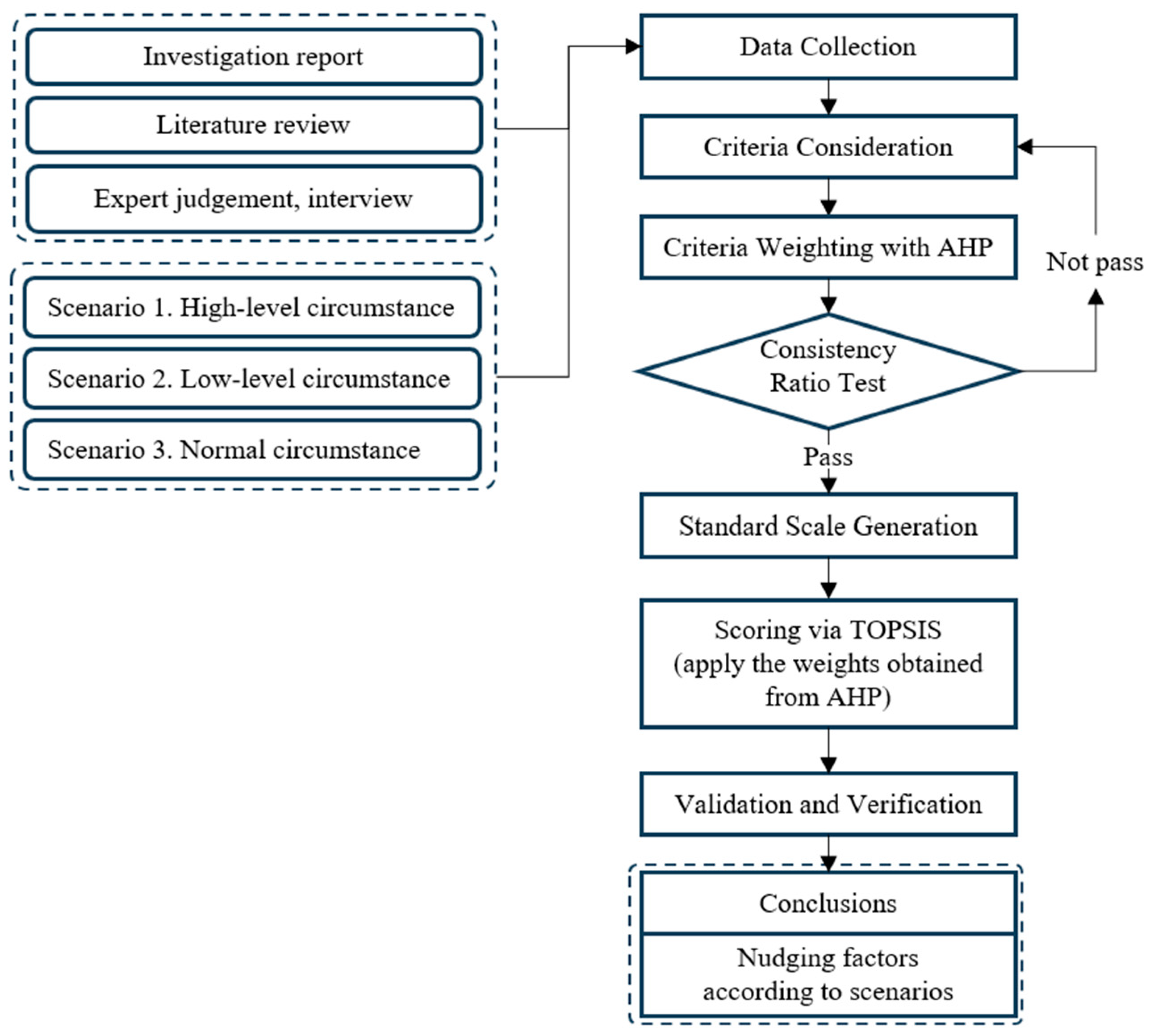
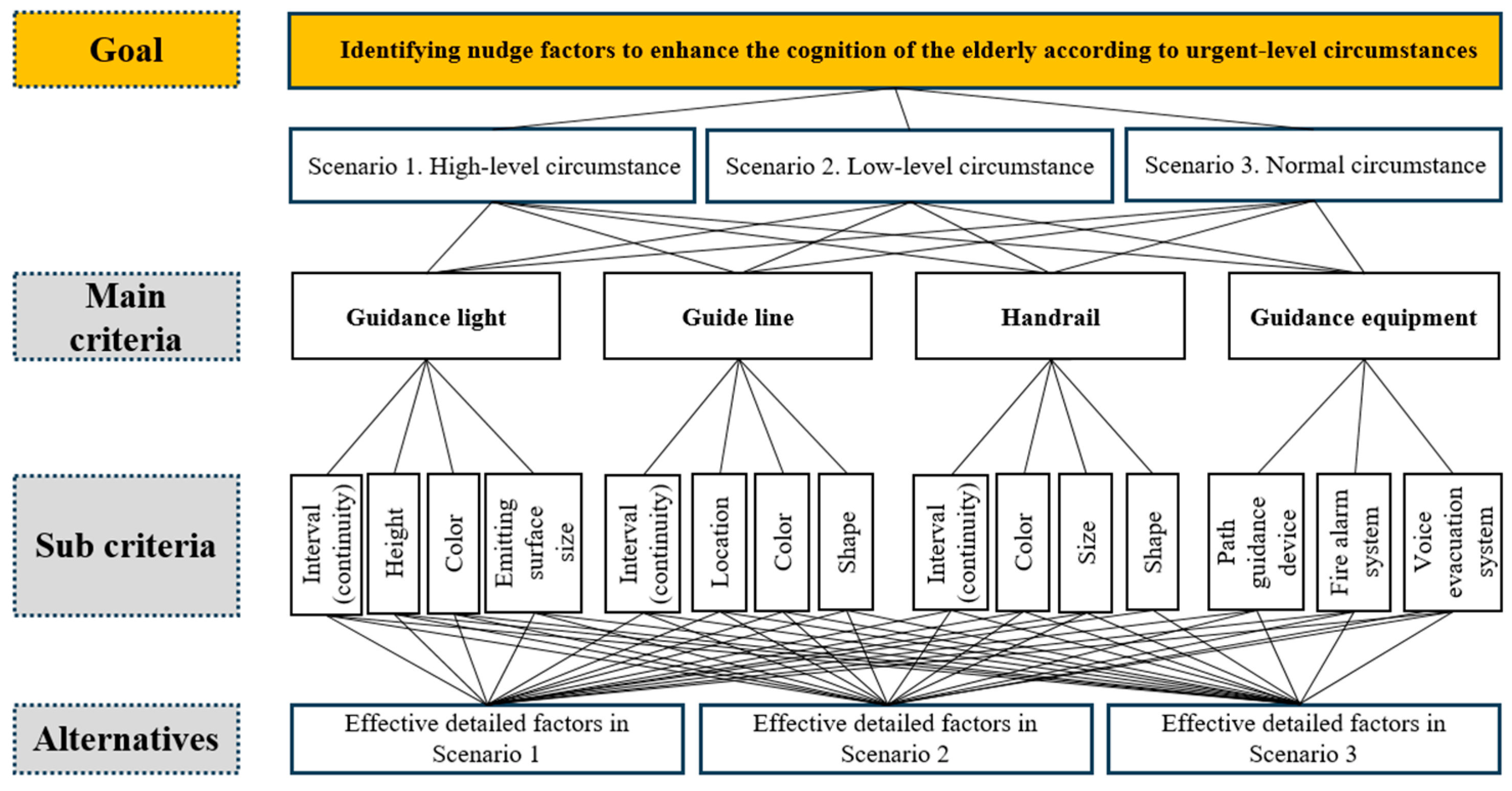

| Main Criteria | Sub-Criteria | ||||||
|---|---|---|---|---|---|---|---|
| Guidance light | Sign lamp indicating the location of nearby exits or evacuation routes |  | 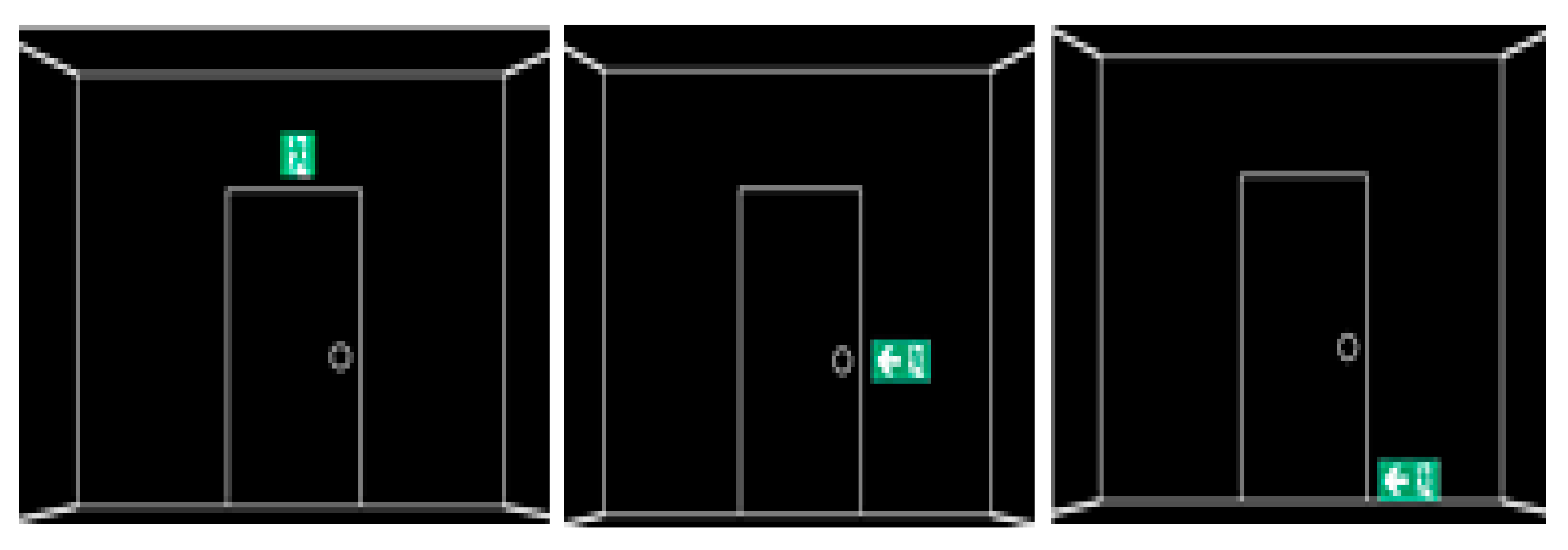 | ||||
| Evacuation information continuity based on guidance light installation intervals | Guidance light installation height | ||||||
| (a) Interval | (b) Height | ||||||
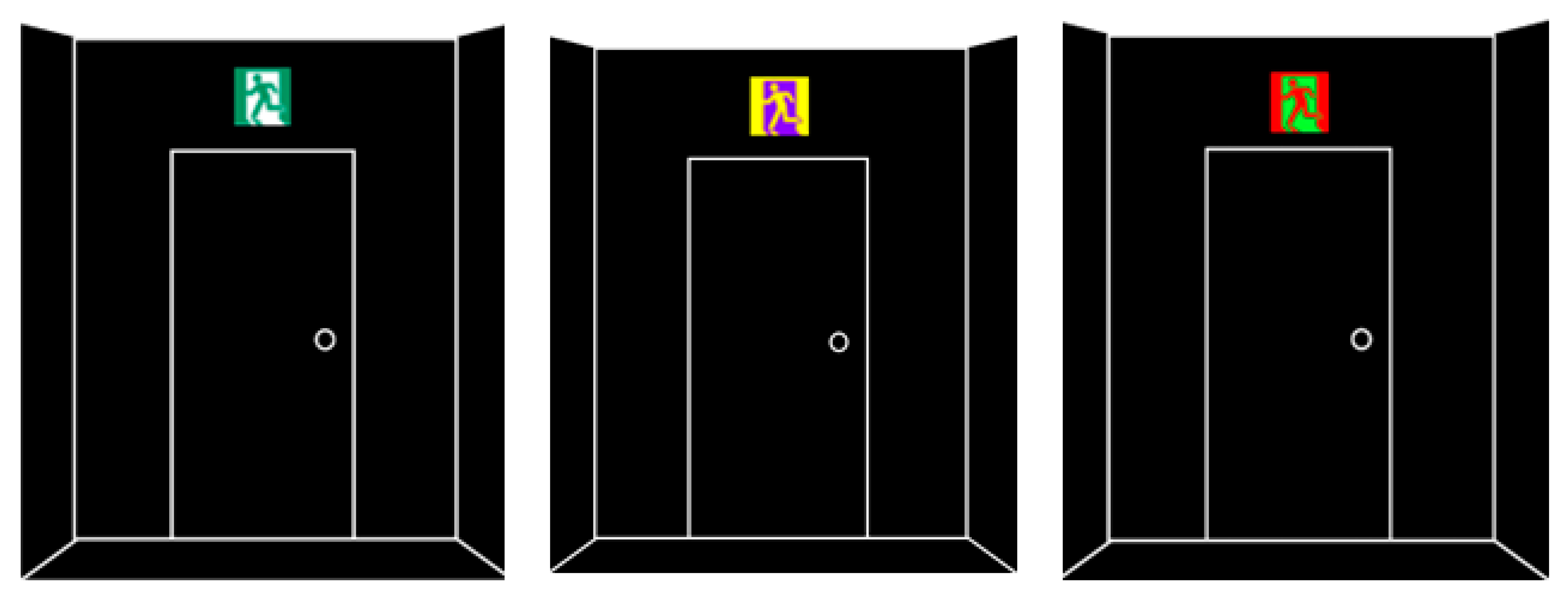 | 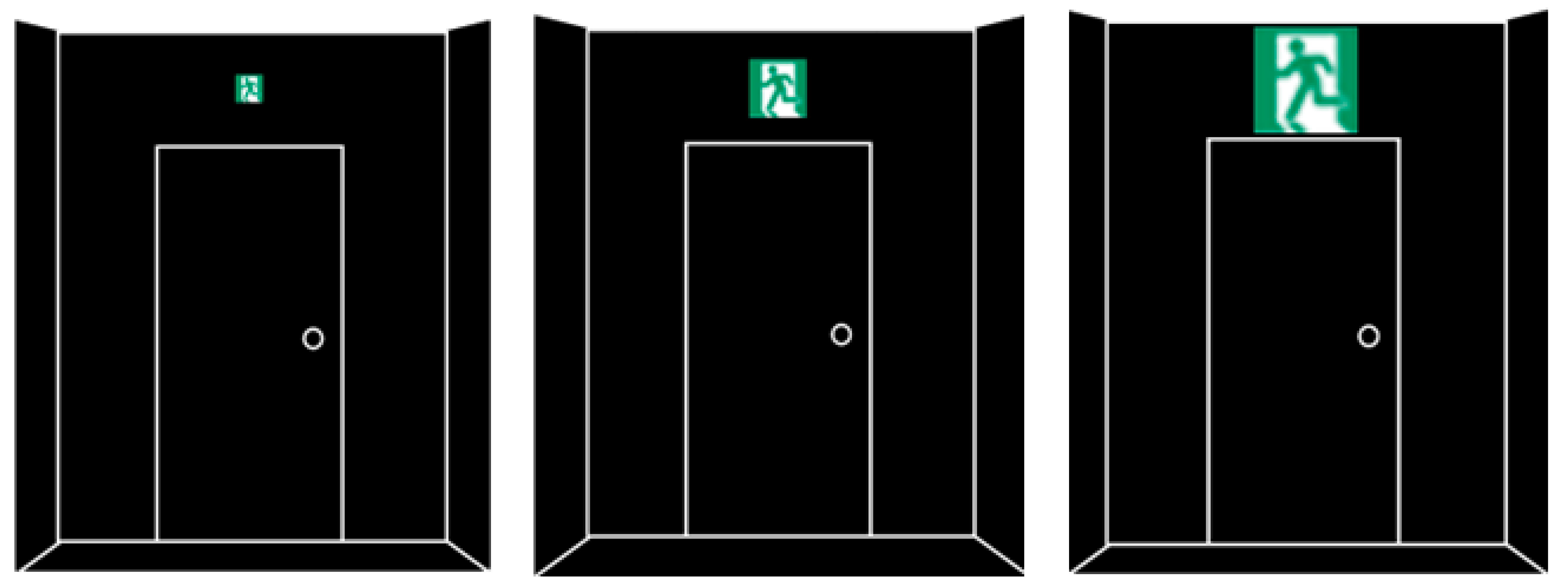 | ||||||
| Guidance light color | Guidance light size | ||||||
| (c) Color | (d) Size | ||||||
| Guide line | Line that emits light, either stored or current, facilitating evacuation in dark environments |  |  | ||||
| Evacuation information continuity based on guide line installation intervals | Installation locations: left and right on the floor, center of the floor, and left and right on the walls | ||||||
| (e) Interval | (f) Location | ||||||
 |  | ||||||
| Guide line color | Guide line shape (arrow, dotted line, and straight line) | ||||||
| (g) Color | (h) Shape | ||||||
| Handrail | Structure on corridor and stair walls, used as walking support and displaying evacuation information | 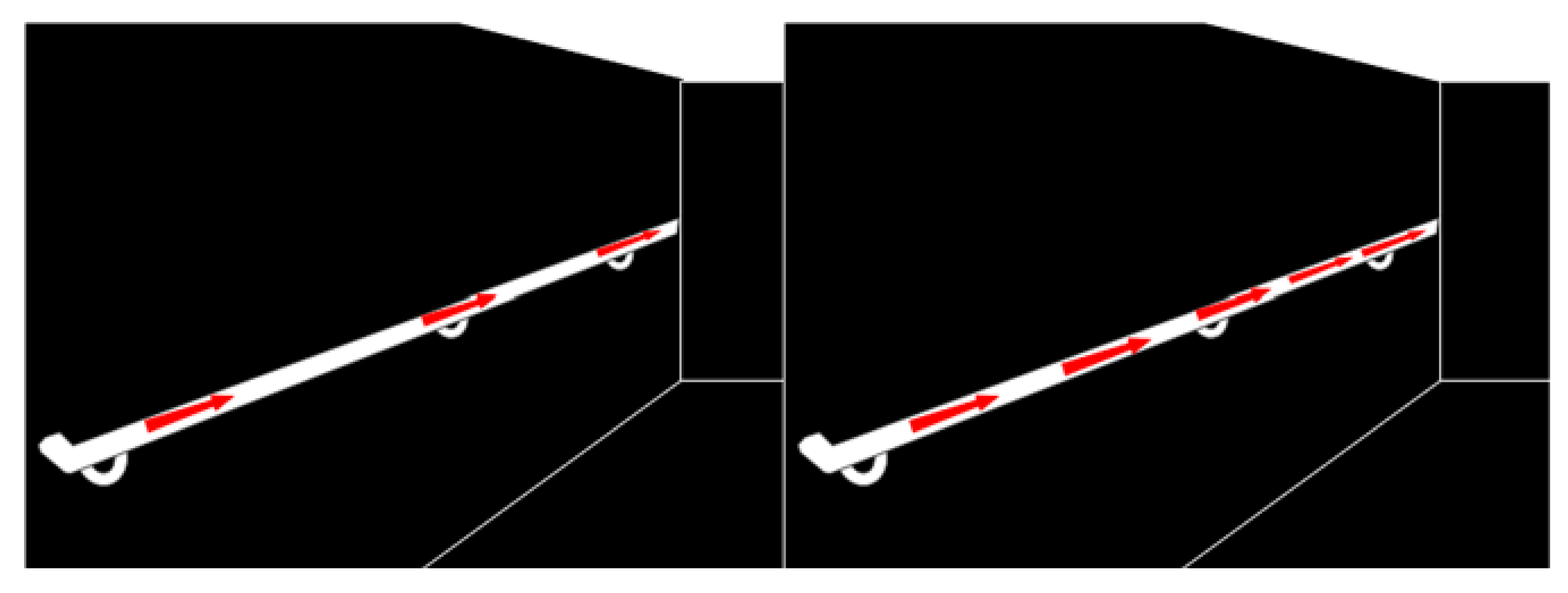 | 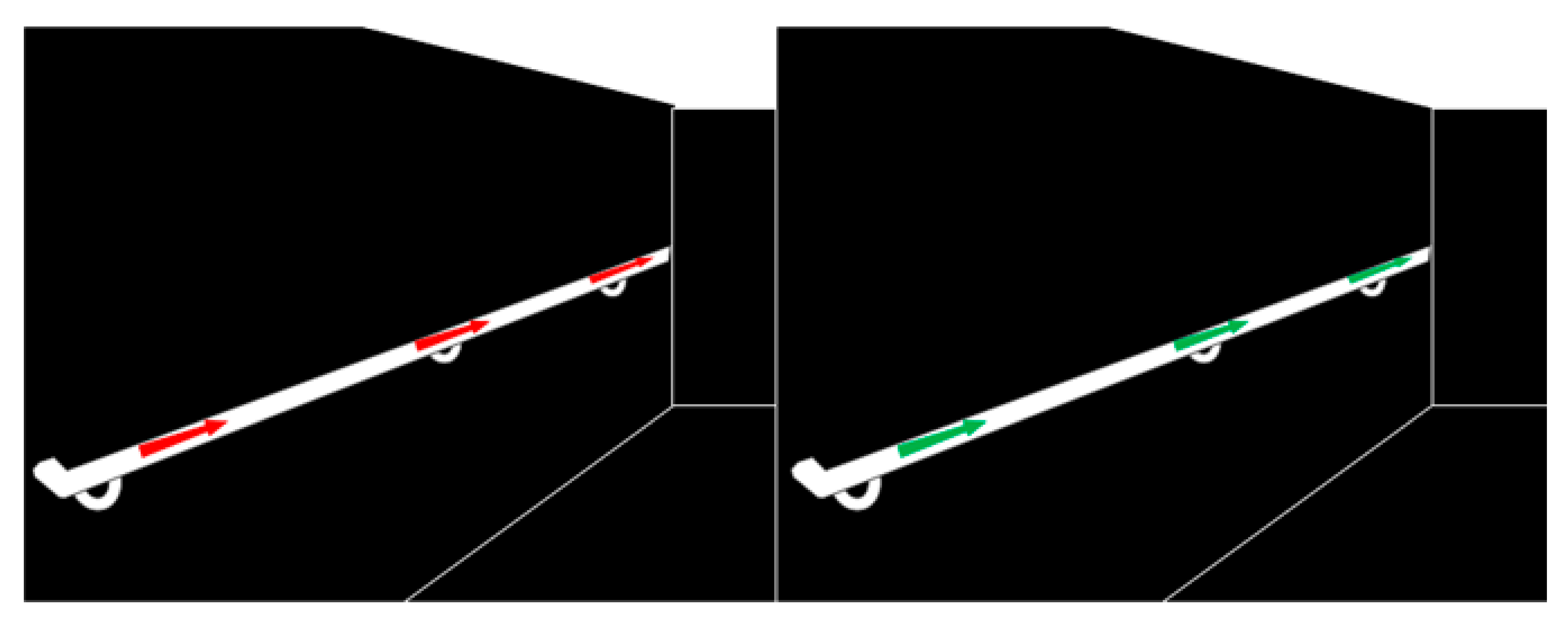 | ||||
| Evacuation information continuity based on display intervals on the handrail surface | Display color on the handrail surface | ||||||
| (i) Interval | (j) Color | ||||||
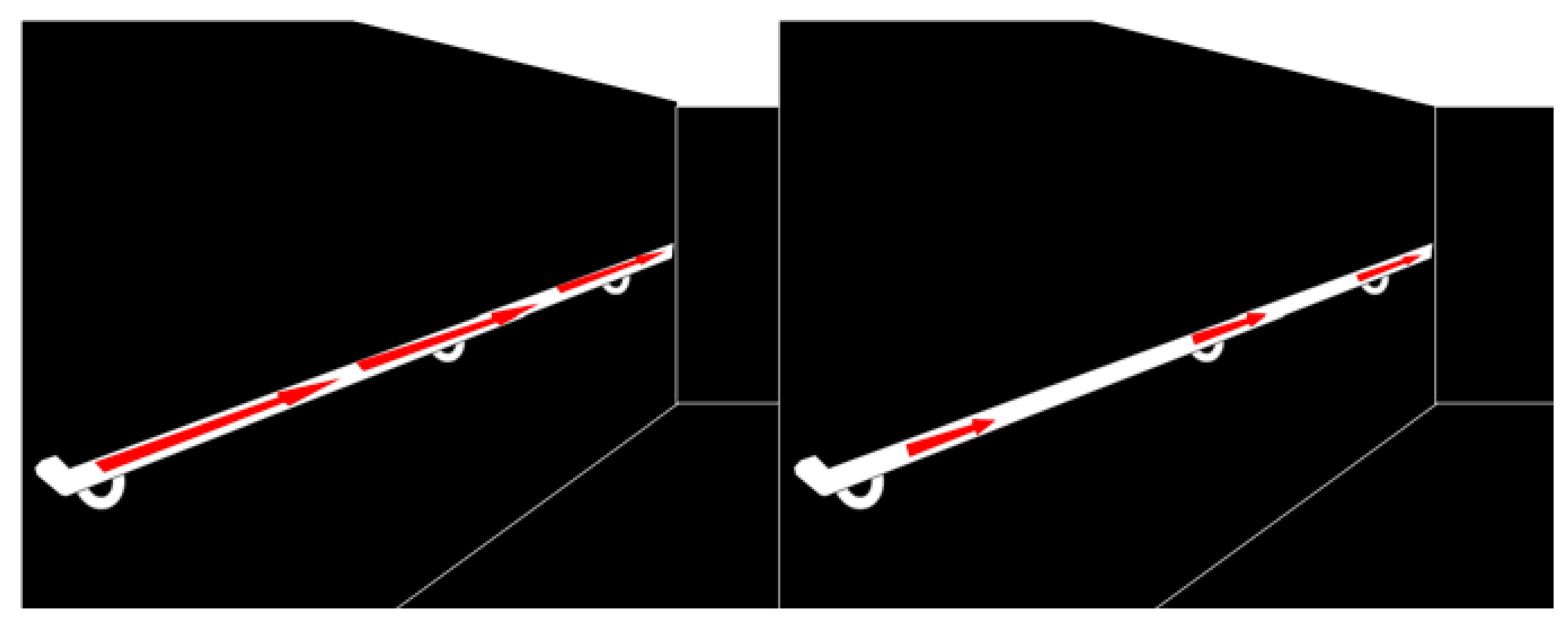 | 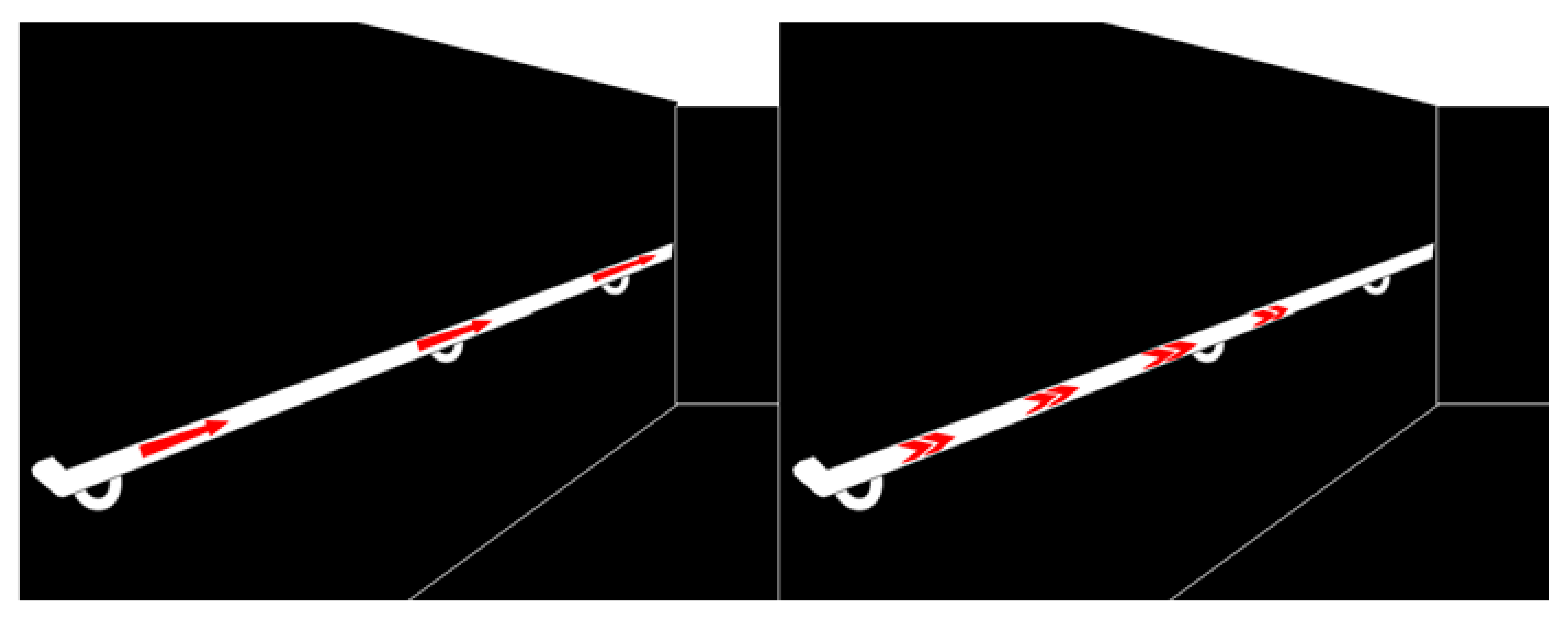 | ||||||
| Display size on the handrail surface | Display shape on the handrail surface (arrow, dotted line, and straight line) | ||||||
| (k) Size | (l) Shape | ||||||
| Guidance equipment | Auditory device to prompt evacuation and issue fire alarms | 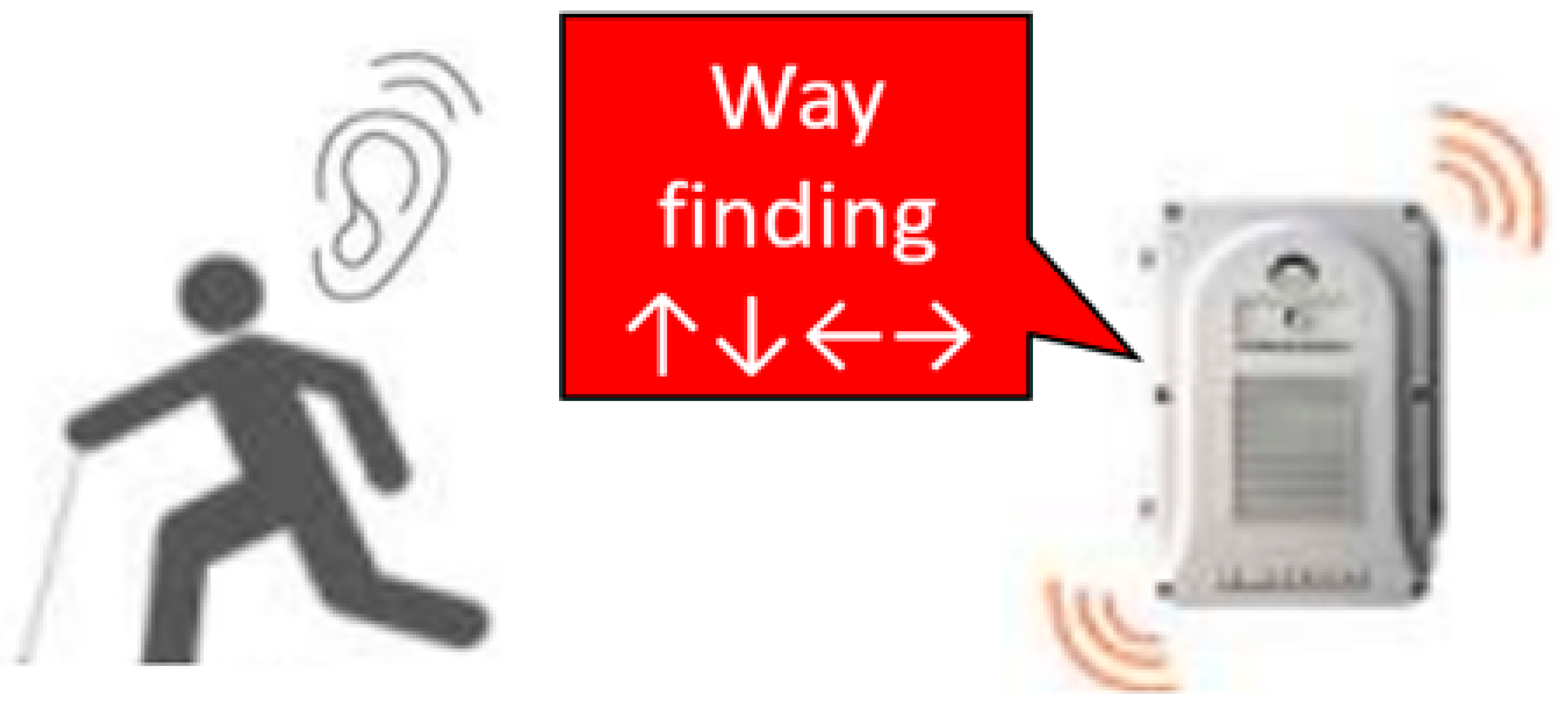 |  |  | |||
| Presence/absence of a path guidance system | Traditional fire alarm system (e.g., fire alarm bell and blaring horns). Presence/absence of a machine that detects smoke or heat and issues a fire alarm. | System that allows a designated individual to inform evacuation procedures through speakers. Presence/absence of a system that can deliver real-time emergency information using a voice evacuation system. | |||||
| (m) Path guidance system | (n) Fire alarm system | (o) Voice evacuation system | |||||
| Scenario | Circumstance | Description |
|---|---|---|
| Scenario 1 | High-level circumstance | Elderly evacuate early owing to severe fire risks. Elevators are inoperable. Continuous fire alarms and alerts guide the evacuation process. Despite differences in cognition and response to evacuation alerts, the elderly simultaneously move toward the exits. The presence of fire is clear, prompting immediate evacuation. |
| Scenario 2 | Low-level circumstance | Fire risks are not immediately threatening; elevators are operational. Those who cannot walk use elevators; others use stairs. All exits are open, with less time variance in heading to exits than in high-risk scenarios. Minor fire anticipated; emergency alerts prompt evacuation. |
| Scenario 3 | Normal circumstance | Nudging factors recognizable in daily life are emphasized. Elderly seek exits and elevators without psychological pressure; fewer simultaneous movements. Departure times to exits are random, with no time constraints. |
| Variable | Item | Academic Field Experts (n = 20) | Practical Field Experts (n = 21) | ||
|---|---|---|---|---|---|
| n | Percentage (%) | n | Percentage (%) | ||
| Gender | Male | 10 | 50 | 8 | 38 |
| Female | 10 | 50 | 13 | 62 | |
| Academic background | Bachelor’s degree or higher | 2 | 10 | 18 | 85.7 |
| Master’s degree or higher | 8 | 40 | 3 | 14.3 | |
| Doctoral degree or higher | 10 | 50 | 0 | ||
| Expert groups | Professor | 4 | 20 | - | - |
| Research | 16 | 80 | - | - | |
| Field expert | - | - | 21 | 100 | |
| Work experience | Less than one year | 4 | 20 | - | - |
| One to three years | 9 | 45 | 9 | 42.8 | |
| More than five years | 7 | 35 | 12 | 57.2 | |
| Scenario | Main Criteria | Weight of Main Criteria | Sub-Criteria | Weight of Sub-Criteria | Weight of Main Criteria X Weight of Sub-Criteria | |||||
|---|---|---|---|---|---|---|---|---|---|---|
| Academic Experts | Practical Experts | Academic Experts | Practical Experts | Academic Experts | Practical Experts | |||||
| Weight | Rank | Weight | Rank | |||||||
| Scenario 1 | Guidance light | 0.31770 | 0.25504 | Interval | 0.34823 | 0.23072 | 0.11063 | 2 | 0.05884 | 8 |
| Height | 0.19058 | 0.23114 | 0.06054 | 8 | 0.05894 | 7 | ||||
| Color | 0.18216 | 0.19706 | 0.05787 | 9 | 0.05025 | 10 | ||||
| Size | 0.27904 | 0.34108 | 0.08865 | 3 | 0.08698 | 3 | ||||
| Guide line | 0.35753 | 0.24970 | Interval | 0.37578 | 0.24803 | 0.13435 | 1 | 0.06193 | 5 | |
| Location | 0.24245 | 0.36457 | 0.08668 | 5 | 0.09103 | 2 | ||||
| Color | 0.23853 | 0.21344 | 0.08528 | 6 | 0.05329 | 9 | ||||
| Shape | 0.14324 | 0.17395 | 0.05121 | 10 | 0.04343 | 13 | ||||
| Handrail | 0.15446 | 0.17936 | Interval | 0.40060 | 0.25373 | 0.06187 | 7 | 0.04550 | 12 | |
| Color | 0.20680 | 0.26570 | 0.03194 | 14 | 0.04765 | 11 | ||||
| Size | 0.26358 | 0.33928 | 0.04071 | 12 | 0.06085 | 6 | ||||
| Shape | 0.12901 | 0.14129 | 0.01992 | 15 | 0.02534 | 15 | ||||
| Guidance equipment | 0.17031 | 0.31590 | Path guidance device | 0.28348 | 0.21824 | 0.04827 | 11 | 0.06894 | 4 | |
| Fire alarm system | 0.51563 | 0.13084 | 0.08781 | 4 | 0.04133 | 14 | ||||
| Voice evacuation system | 0.20089 | 0.65092 | 0.03421 | 13 | 0.20562 | 1 | ||||
| Scenario 2 | Guidance light | 0.23319 | 0.31372 | Interval | 0.29854 | 0.21340 | 0.06961 | 6 | 0.06694 | 6 |
| Height | 0.21122 | 0.23661 | 0.04925 | 10 | 0.07422 | 5 | ||||
| Color | 0.20366 | 0.19737 | 0.04749 | 11 | 0.06191 | 8 | ||||
| Size | 0.28658 | 0.35263 | 0.06682 | 7 | 0.11062 | 2 | ||||
| Guide line | 0.36750 | 0.24421 | Interval | 0.34124 | 0.24761 | 0.12540 | 1 | 0.06046 | 9 | |
| Location | 0.31079 | 0.31844 | 0.11421 | 2 | 0.07776 | 4 | ||||
| Color | 0.22212 | 0.27215 | 0.08162 | 4 | 0.06646 | 7 | ||||
| Shape | 0.12585 | 0.16180 | 0.04624 | 12 | 0.03951 | 11 | ||||
| Handrail | 0.18976 | 0.14452 | Interval | 0.32154 | 0.26700 | 0.06101 | 8 | 0.03858 | 12 | |
| Color | 0.22233 | 0.25495 | 0.04218 | 14 | 0.03684 | 13 | ||||
| Size | 0.29918 | 0.30731 | 0.05677 | 9 | 0.04441 | 10 | ||||
| Shape | 0.15695 | 0.17074 | 0.02978 | 15 | 0.02467 | 15 | ||||
| Guidance equipment | 0.20955 | 0.29755 | Path guidance device | 0.33528 | 0.33524 | 0.07025 | 5 | 0.09975 | 3 | |
| Fire alarm system | 0.45059 | 0.11011 | 0.09442 | 3 | 0.03276 | 14 | ||||
| Voice evacuation system | 0.21413 | 0.55465 | 0.04487 | 13 | 0.16503 | 1 | ||||
| Scenario 3 | Guidance light | 0.21080 | 0.25200 | Interval | 0.36323 | 0.20223 | 0.07656 | 5 | 0.05096 | 9 |
| Height | 0.26181 | 0.24425 | 0.05518 | 9 | 0.06155 | 7 | ||||
| Color | 0.16129 | 0.22707 | 0.03399 | 13 | 0.05722 | 8 | ||||
| Size | 0.21367 | 0.32646 | 0.04504 | 11 | 0.08226 | 3 | ||||
| Guide line | 0.34675 | 0.18296 | Interval | 0.35646 | 0.20985 | 0.12360 | 1 | 0.03839 | 14 | |
| Location | 0.32064 | 0.34469 | 0.11118 | 3 | 0.06306 | 6 | ||||
| Color | 0.19441 | 0.25294 | 0.06741 | 7 | 0.04627 | 10 | ||||
| Shape | 0.12849 | 0.19251 | 0.04455 | 12 | 0.03522 | 15 | ||||
| Handrail | 0.20244 | 0.19867 | Interval | 0.38468 | 0.22770 | 0.07787 | 4 | 0.04523 | 11 | |
| Color | 0.16293 | 0.21929 | 0.03298 | 14 | 0.04356 | 13 | ||||
| Size | 0.29601 | 0.33267 | 0.05992 | 8 | 0.06609 | 5 | ||||
| Shape | 0.15639 | 0.22034 | 0.03165 | 15 | 0.04377 | 12 | ||||
| Guidance equipment | 0.24000 | 0.36637 | Path guidance device | 0.21594 | 0.21675 | 0.05182 | 10 | 0.07941 | 4 | |
| Fire alarm system | 0.48011 | 0.53477 | 0.11522 | 2 | 0.19592 | 1 | ||||
| Voice evacuation system | 0.30395 | 0.24848 | 0.07294 | 6 | 0.09103 | 2 | ||||
| Scenario | Main Criteria | Sub-Criteria | TOPSIS | |||
|---|---|---|---|---|---|---|
| di+ | di− | CCi | Rank | |||
| Scenario 1 | Guidance light | Interval | 0.027 | 0.190 | 0.126 | 7 |
| Height | 0.011 | 0.192 | 0.055 | 12 | ||
| Color | 0.011 | 0.194 | 0.054 | 13 | ||
| Size | 0.028 | 0.179 | 0.134 | 6 | ||
| Guide line | Interval | 0.042 | 0.185 | 0.186 | 3 | |
| Location | 0.030 | 0.175 | 0.146 | 5 | ||
| Color | 0.025 | 0.188 | 0.117 | 8 | ||
| Shape | 0.012 | 0.194 | 0.059 | 11 | ||
| Handrail | Interval | 0.020 | 0.189 | 0.097 | 9 | |
| Color | 0.010 | 0.191 | 0.048 | 14 | ||
| Size | 0.019 | 0.182 | 0.095 | 10 | ||
| Shape | 0.000 | 0.199 | 0.000 | 15 | ||
| Guidance equipment | Path guidance device | 0.034 | 0.169 | 0.168 | 4 | |
| Fire alarm system | 0.056 | 0.176 | 0.240 | 2 | ||
| Voice evacuation system | 0.194 | 0.026 | 0.881 | 1 | ||
| Scenario 2 | Guidance light | Interval | 0.010 | 0.153 | 0.060 | 10 |
| Height | 0.010 | 0.153 | 0.060 | 11 | ||
| Color | 0.007 | 0.156 | 0.042 | 12 | ||
| Size | 0.023 | 0.139 | 0.144 | 6 | ||
| Guide line | Interval | 0.030 | 0.148 | 0.167 | 5 | |
| Location | 0.030 | 0.141 | 0.175 | 4 | ||
| Color | 0.019 | 0.146 | 0.117 | 7 | ||
| Shape | 0.004 | 0.159 | 0.023 | 14 | ||
| Handrail | Interval | 0.012 | 0.155 | 0.073 | 9 | |
| Color | 0.006 | 0.158 | 0.035 | 13 | ||
| Size | 0.015 | 0.151 | 0.092 | 8 | ||
| Shape | 0.000 | 0.162 | 0.002 | 15 | ||
| Guidance equipment | Path guidance device | 0.057 | 0.107 | 0.347 | 2 | |
| Fire alarm system | 0.057 | 0.140 | 0.289 | 3 | ||
| Voice evacuation system | 0.156 | 0.024 | 0.868 | 1 | ||
| Scenario 3 | Guidance light | Interval | 0.012 | 0.140 | 0.082 | 9 |
| Height | 0.007 | 0.140 | 0.047 | 12 | ||
| Color | 0.004 | 0.143 | 0.024 | 15 | ||
| Size | 0.012 | 0.135 | 0.080 | 10 | ||
| Guide line | Interval | 0.033 | 0.134 | 0.196 | 4 | |
| Location | 0.030 | 0.126 | 0.194 | 5 | ||
| Color | 0.014 | 0.137 | 0.095 | 8 | ||
| Shape | 0.005 | 0.144 | 0.034 | 14 | ||
| Handrail | Interval | 0.022 | 0.133 | 0.143 | 7 | |
| Color | 0.006 | 0.141 | 0.040 | 13 | ||
| Size | 0.024 | 0.124 | 0.162 | 6 | ||
| Shape | 0.009 | 0.137 | 0.062 | 11 | ||
| Guidance equipment | Path guidance device | 0.040 | 0.107 | 0.271 | 3 | |
| Fire alarm system | 0.147 | 0.000 | 1.000 | 1 | ||
| Voice evacuation system | 0.100 | 0.050 | 0.666 | 2 | ||
Disclaimer/Publisher’s Note: The statements, opinions and data contained in all publications are solely those of the individual author(s) and contributor(s) and not of MDPI and/or the editor(s). MDPI and/or the editor(s) disclaim responsibility for any injury to people or property resulting from any ideas, methods, instructions or products referred to in the content. |
© 2025 by the authors. Licensee MDPI, Basel, Switzerland. This article is an open access article distributed under the terms and conditions of the Creative Commons Attribution (CC BY) license (https://creativecommons.org/licenses/by/4.0/).
Share and Cite
Ryu, J.; Kim, S.-K.; Lee, H.-K.; Hong, W.-H.; Kim, Y.-C. Nudge-Based Intervention for Cognitive Enhancement of Elderly in Long-Term Care Facilities During Fire Evacuation According to Urgent-Level Circumstances. Buildings 2025, 15, 1269. https://doi.org/10.3390/buildings15081269
Ryu J, Kim S-K, Lee H-K, Hong W-H, Kim Y-C. Nudge-Based Intervention for Cognitive Enhancement of Elderly in Long-Term Care Facilities During Fire Evacuation According to Urgent-Level Circumstances. Buildings. 2025; 15(8):1269. https://doi.org/10.3390/buildings15081269
Chicago/Turabian StyleRyu, Jihye, Sung-Kyung Kim, Hye-Kyoung Lee, Won-Hwa Hong, and Young-Chan Kim. 2025. "Nudge-Based Intervention for Cognitive Enhancement of Elderly in Long-Term Care Facilities During Fire Evacuation According to Urgent-Level Circumstances" Buildings 15, no. 8: 1269. https://doi.org/10.3390/buildings15081269
APA StyleRyu, J., Kim, S.-K., Lee, H.-K., Hong, W.-H., & Kim, Y.-C. (2025). Nudge-Based Intervention for Cognitive Enhancement of Elderly in Long-Term Care Facilities During Fire Evacuation According to Urgent-Level Circumstances. Buildings, 15(8), 1269. https://doi.org/10.3390/buildings15081269








